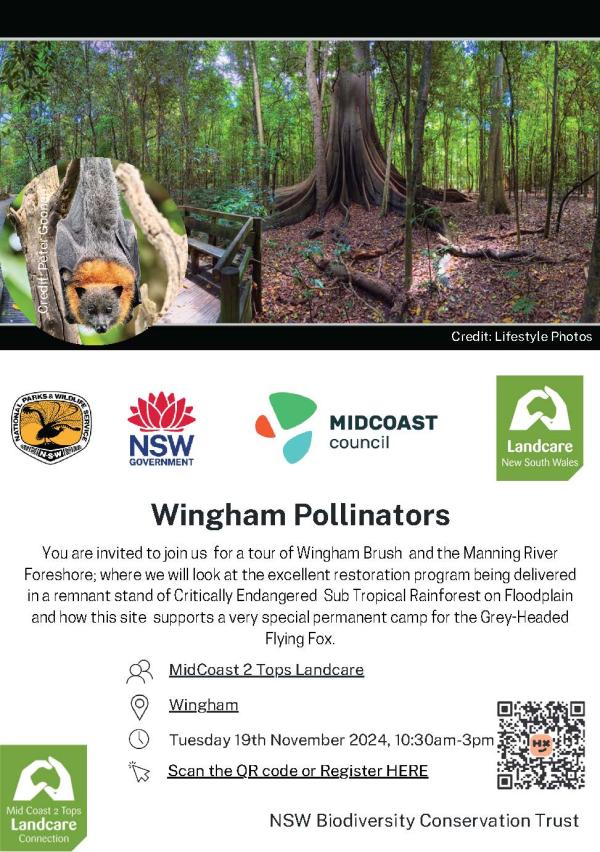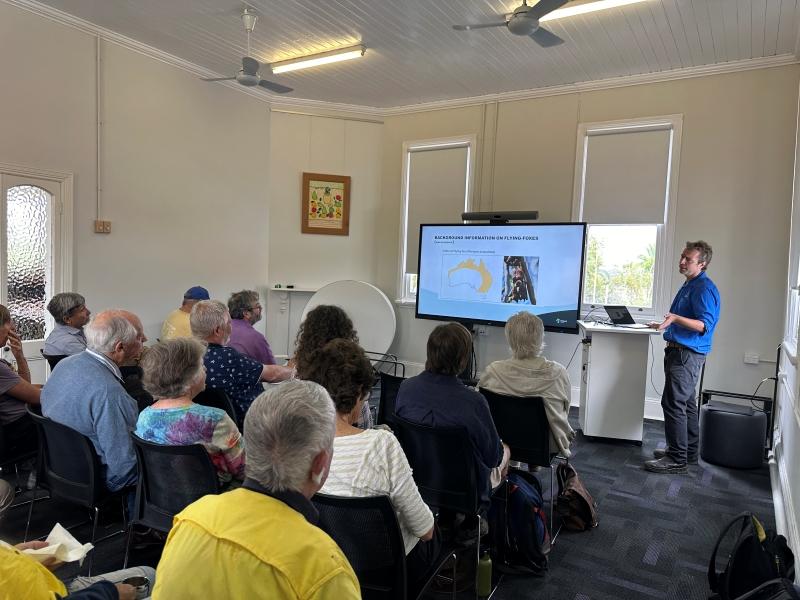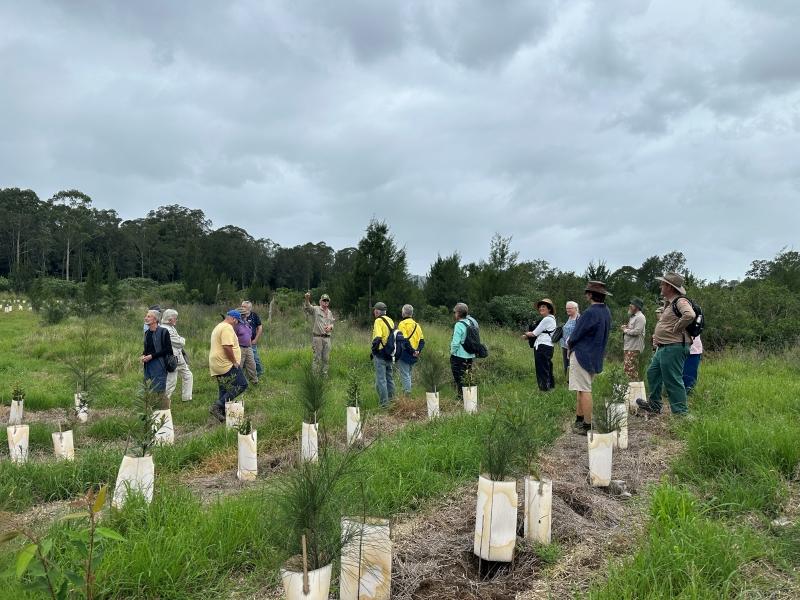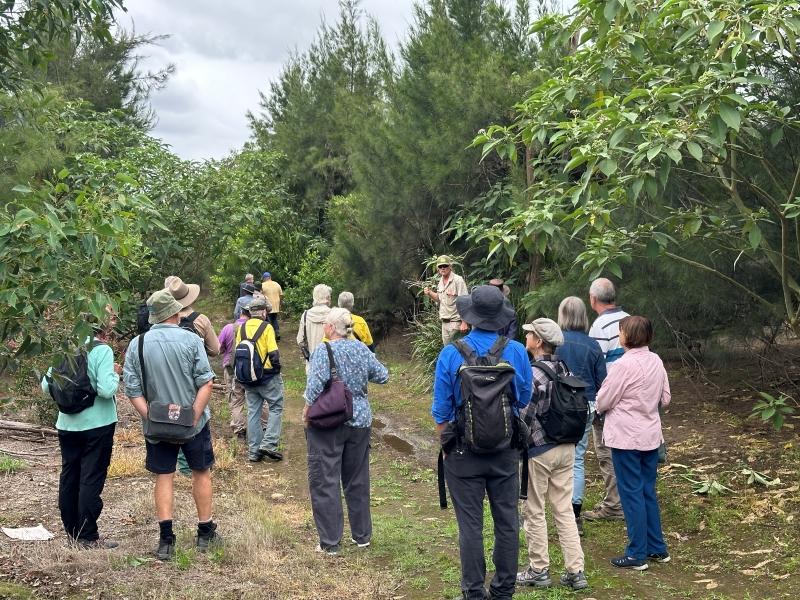Event Type
Landcare Region
BCT Region
Field Day 10: Feral Animal Workshop, Coopernook- Now threatened animals at Wingham Brush
LLS have been running extensive feral control workshops and an alternative topic is being identified
Join us at Wingham Library to learn about the restoration projects being implemented in and around Wingham Brush. You will hear from local restoration expert, Scott Meier (BARRC) about the principles of natural area restoration; and Nicholas Colman about the local programs being delivered to protect the Grey-Headed Flying Fox (Pteropus poliocephalus) population at Wingham, and why this species is so important as an ecosystem vector and pollinator.
The Wingham Brush population is one of the only permanent camps for Pteropus poliocephalus, which is listed as Vulnerable at both State and Federal levels. We will go for a walk through the Brush and along the Manning River Foreshore and see how the areas are recovering from recent impacts, such as the major flooding of 2022; observe restoration efforts, and take a look at the resident Grey-Headed Flying Fox population (and other species of bat) in the Brush.
Staff from the Biodiversity Conservation Trust, Midcoast Council, MidCoast2Tops Landcare and National Parks and Wildlife Service will share their knowledge and expertise on the day.
You will have a chance to meet other landholders in the Private Land Conservation network and share stories and experiences on the day.
Morning Tea and Lunch will be provided.





Event Outcomes
Growth in learning measure (Scale 1 - 100)
The final event in the PLCM program was held on Tuesday 19th November in Wingham where we learnt all about the extraordinary efforts that have gone into the restoration and conservation of Wingham Brush and the foreshore reserve adjacent to the Brush. This incredible story has evolved over many decades with numerous people driving the program to save this high conservation value area in Wingham, which is now home to the only permanent colonies (roosting and maternity site) for the Vulnerable Grey-Headed Flying Fox between Bellingen and the Hunter Valley.
Australia is home to four species of flying fox, of which the Grey-Headed and the Little Red are endemic and only found in Australia. The Spectacled and the Black Flying Fox are also known to occur in Indonesia and Papua New Guinea. Of these four species of Flying Fox, only the Spectacled Flying Fox does not utilise the Wingham Brush site, with the Little Red and Black Flying Foxes now commonly seen at the Brush.
The local Biripi people called this area Wignan – which means “where bats come to drink” in the local Gathung language. Of course, Aboriginal people knew the inherent value of Flying Foxes, both as spiritual totems and for their role in ecosystem processes, which is well documented in their art and oral history across many tribal groups. Interestingly, the Manning River was called Boolumbahtee in Gathung, meaning a place where the brolgas played.
Grey-Headed Flying Foxes are often called ‘Ecosystem Engineers’. This is because of their eating and foraging habits. They eat vast amounts of pollen from a large variety of native tree species, including our local Eucalypts. Given they can travel up to 50km a day, Flying Foxes are actively distributing genetic material and assisting pollination within our local forests, thus enabling propagation and genetic diversification within these important ecosystems. They have a high metabolic rate which means they defecate within 30 minutes of eating, but they are capable of eating large fruit, and thus carrying and distributing seeds within their flight paths. A lot of our rainforest species produce fleshy fruits which are prime tucker for these species, and so the integral relationship between these mammals and rainforest distribution is critical.
We were fortunate enough to have two wildlife carers in attendance on Tuesday, Barbara and Sandie, who were looking after a couple of orphaned baby Grey-Headed Flying Fox. A rare, and very special opportunity to see these little cuties in close proximity.
Scott Meier (BARRC) gave an excellent overview of rainforest types and restoration principles before we headed out for a guided tour of the Brush with Peter Katsamagos from the National Parks and Wildlife Discovery Program. We saw (and smelt!) the GHFF colony up close, and then had a very interesting walk over the foreshore area where Scott shared his experience and knowledge of a most challenging riparian restoration project.
Event Feedback Summary
What attendees liked about the event:
- Relevant Topics: Interest in the overall subject area and focus on bush regeneration.
- Format: Positive feedback on the combination of talks and walks.
- Networking: Enjoyed the opportunity to socialise with like-minded individuals.
- Learning: Appreciated the chance to gain more knowledge.
What attendees want to learn next:
- Landholder Support: More information on programs accessible to small landholders.
- Ecological Techniques: Streambank regeneration methods.
- Biodiversity: Importance of invertebrates in ecosystems.
Suggestions for improvement:
- Provide a brief handout on the different types of flying foxes.
